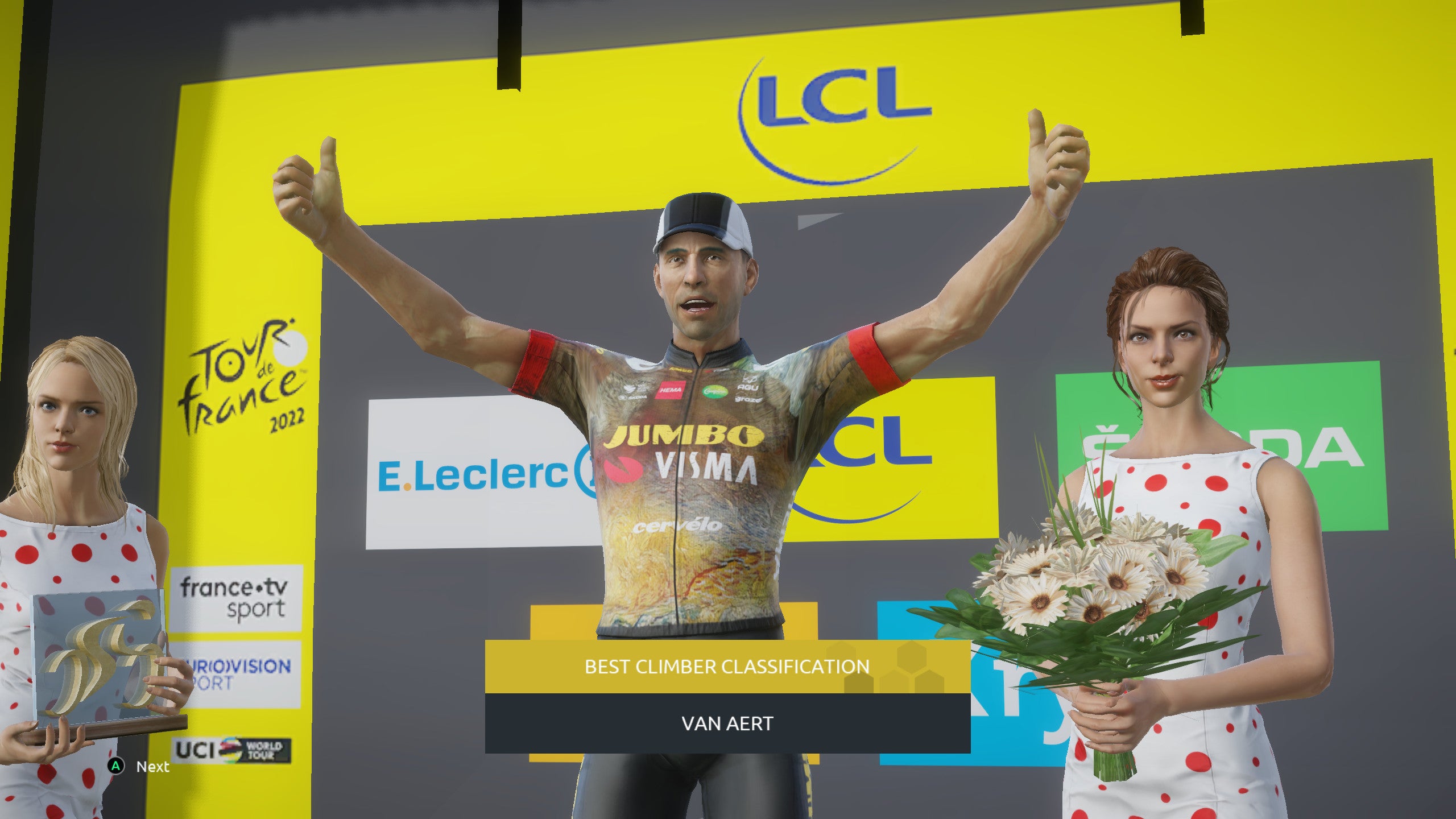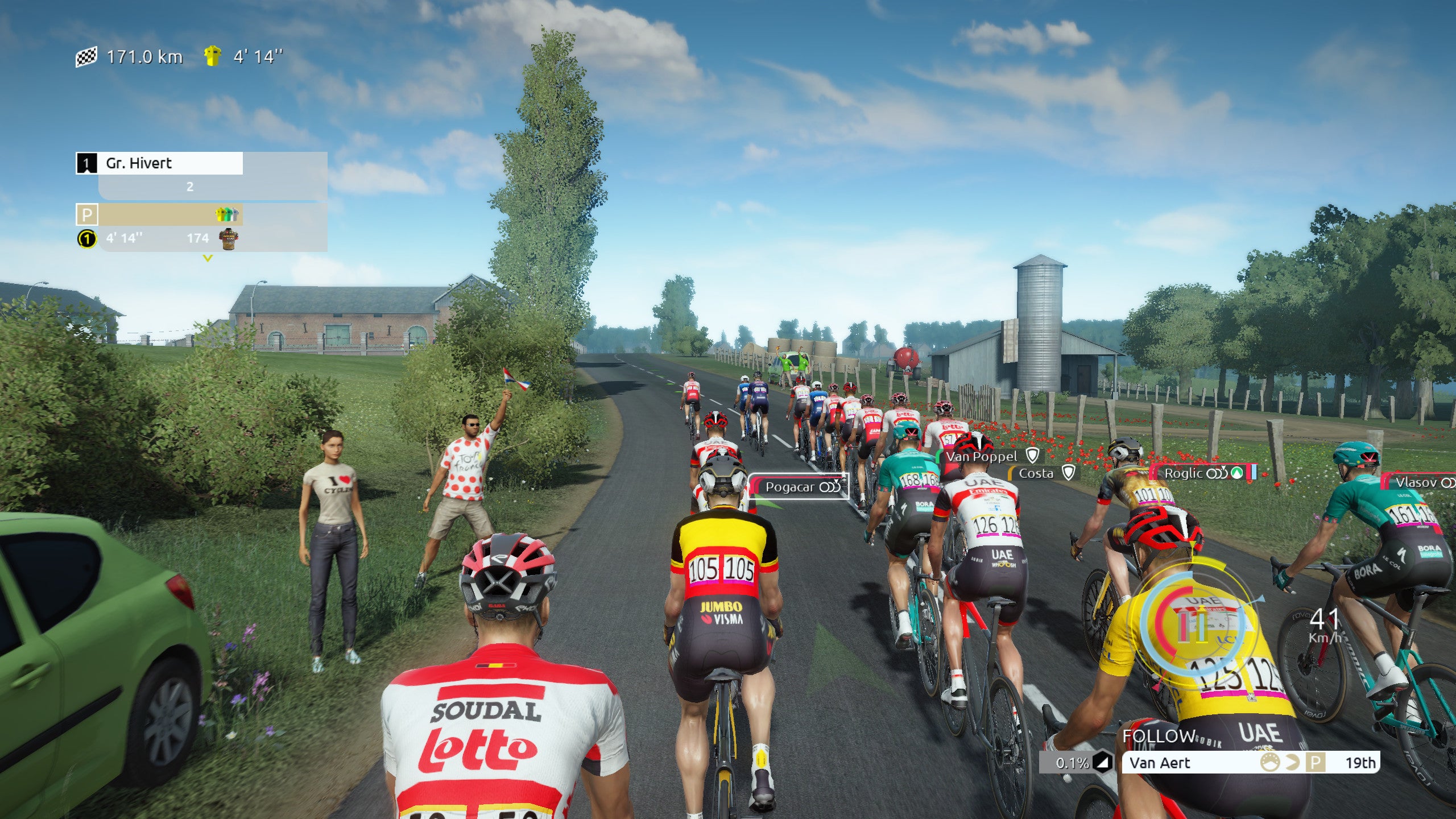Products You May Like
The Tour De France, the grandest race in professional cycling, started today. Across three weeks, 176 cyclists will ride 3328 kilometres (2068 miles) winding through France, Denmark, Belgium, and Switzerland, including the Alps and Pyrenees. As a keen cyclist and avid Tour watcher myself, I’m excited. So in celebration, over the coming weeks I’ll be gabbing about the Tour De France, cycling, and bikes in a wide variety of video games with my own Tour De Jeux, from big-budget open-world extravaganzas to cute wee indie adventures. Let’s start in the obvious place: the official Tour De France video game.
Tour De France 2022, the video game, is strange. It doesn’t feel riding a bike as a cyclist, nor does it feel like watching the Tour De France as a spectator. It’s a slimline simulation sitting in an uneasy middle ground, and even the game itself says large parts are probably boring.
It broadly replicates the 21 stages of this year’s Tour (plus some other races) then lets us have a go. The cycling is controlled by one trigger, one thumbstick, and two buttons on a gamepad (no keyboard and mouse support). You can try to take the optimal line on every turn and constantly adjust your position to hide from the wind, but this moment-to-moment experience is not satisfying. The game agrees this is not interesting. It gives you the option to hold X to automatically keep pace with the rider ahead, or even set the race to fast-forward and have AI fully take control until you want back in. Your team manager will call you on the radio during long sections to suggest you fast-forward, which feels like a strange confession.
This is the problem: the real Tour De France is long and largely slow. Each main stage takes three to six hours, and riders mostly trundle along together in the peloton (albeit trundling at 40kmh). Dramatic action is often confined to the big finish and pushes for the checkpoints which offer bonus points in several sub-competitions. Even when a small group or single rider strike out ahead, their breakaway will often be effortlessly swallowed by the peloton an hour down the road because it’s so much more tiring to fight wind resistance by yourself. Much of the real TDF is saving energy for key moments, and in the video game too.

With moment-to-moment racing optional, the game is all about managing energy. Mash A for a burst of speed and it’ll burn through your self-replenishing red energy bar, while your blue energy bar is slow to deplete and reflects overall weariness. When you’re nearing the final sprint or the banners for bonus points, you want to have enough left in your legs. I do not find it an interesting system to manage. Given the focus on energy, I am also sorry that our revitalising supplies are refilled magically at feed points rather than making us grab a tote bag full of snacks from the arm of a fella (officially titled a soigneur) standing in the road. Cycling is one of the few sports where eating during competition is encouraged, which I consider a strong point in its favour, and I do always find that a nice little low-tech human moment (I’d be even more delighted if riders still raided bistros for booze).
While the game suggests you fast-forward through quiet parts, I relish these moments in the real world race as a spectator. For the next three weeks, I’ll have the Tour De France playing on my second monitor, mostly acting as ‘slow TV’. It passes beautiful landscapes, from quaint villages and gentle summer countryside to rolling rivers and dizzying mountain passes. The commentators (I watch on GCN/Eurosport) often become tour guides, pointing out interesting places and landmarks, telling histories and offering little facts. Vitally, they’re also storytellers in a soap opera which unfolds across the race. As in most sports, the heart is in stories, and the Tour De France builds and retells tales about riders, teams, the race itself, and even the bikes.

One of the best stories in last year’s Tour was the return of Mark Cavendish. The Manx sprinter had struggled with his physical and mental health for several years, missing the 2019 and 2020 Tours, and he came close to retiring. He wasn’t even due to ride in 2021’s race until an injured teammate dropped out and he was drafted as a replacement days before the start. After all this, Cavendish went on to win four stages. His first win was a glorious moment after everything he’d been through, a joy for him and for spectators. Then as he kept winning, he crept closer to the lifetime TDF stage wins record held by Eddy Merckx for over 40 years. Cavendish missed breaking that record by mere metres in the final stage, losing on the Champs-Élysées to a rising star with his own story (and his own song). Cavendish wasn’t picked this year and it’s not clear when he’ll get another chance, so maybe that now-joint record will stand for another few decades, the legend growing.
That’s what the Tour De France is to me: a sightseeing soap opera. It’s like Coach Trip except on £12,000 bicycles and the lads never skip leg day.
I will stick with this game, for now. I will start a fresh save (my Wout van Aert is doing poorly, though he is King of the Mountains) and ride alongside the real race each day. Maybe drama will develop, or at least it’ll be interesting to see its intepretations of the landscapes. I wish it felt more like riding a bike. I’d forgive a lot if it felt a tiny bit more like riding a bike.

I cycle a fair bit myself. While I’m no racer, I ride many evenings and on weekends usually hit my favourite 80km route along the coast. That’s three-and-a-half hours to me and I relish the slow moments when ‘nothing’ is happening, full of little pleasures. I like shifting gear with each small change in terrain to keep my legs spinning at an optimal rate. I like to look down and watch the chainset turn with my feet. I like to look ahead and watch my shadow. I enjoy the hum of tyres on tarmac and the faint whirr of a well-lubricated bike, and bristle at the noise of skids and shudders on a rough surface or ambitious turn. I like the sound of birds in trees and wind through leaves. I like remembering the regular timing to eat and drink. I like fast descents and do, eventually, like the few wee climbs. The experience of being on a bike is plenty pleasurable but here it’s too quiet, too flat, too dead. While I don’t expect a video game to capture physical sensations of cycling, some others do evoke a little of the joy, the freedom, and the tension.
Across the next few weeks, I want to tell you about many bikes in many games from many genres. They focus on different types and aspects of cycling, and it’s been great to explore. I’ve bunny-hopped a bicycle through a battlefield, I’ve raced downhill at paces which made me twist in my chair in physical discomfort, I’ve pulled wikkid sikk stuntz with gnarly dudes wearing stupid costumes, I’ve joined a Dutch lad’s trip in a visual novel, I’ve played an RPG by feeding it Strava stats from my real rides, and more. I think this will be fun.
